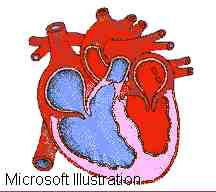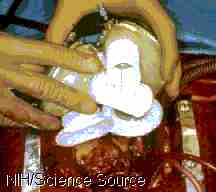 Heart,
in anatomy, the hollow muscular organ that receives blood from the veins
and propels it into and through the arteries. The heart of a human is about
the size of a closed fist. It is situated behind the lower part of the
breastbone, extending more to the left of the midline than to the right.
It is roughly conical in shape, with the base directed upward and to the
right and slightly backward; the apex touches the chest wall between the
fifth and sixth ribs. The heart is held in place principally by its attachment
to the great arteries and veins, and by its confinement in the pericardium,
a double-walled sac with one layer enveloping the heart and the other attached
to the breastbone, the diaphragm, and the membranes of the thorax.
Heart,
in anatomy, the hollow muscular organ that receives blood from the veins
and propels it into and through the arteries. The heart of a human is about
the size of a closed fist. It is situated behind the lower part of the
breastbone, extending more to the left of the midline than to the right.
It is roughly conical in shape, with the base directed upward and to the
right and slightly backward; the apex touches the chest wall between the
fifth and sixth ribs. The heart is held in place principally by its attachment
to the great arteries and veins, and by its confinement in the pericardium,
a double-walled sac with one layer enveloping the heart and the other attached
to the breastbone, the diaphragm, and the membranes of the thorax.
Within the
adult heart are two parallel independent systems, each consisting of an
auricle, or atrium, and a ventricle; from their anatomical positions these
systems are often designated the right heart and the left heart.
Heart Diseases

Disorders of
the heart kill more Americans than any other disease. They can arise from
congenital defects, infection, narrowing of the coronary arteries, high
blood pressure, or disturbances of heart rhythm.
Congenital
heart defects include persistence of fetal connections between the arterial
and venous circulations, such as the ductus arteriosus, a vessel normally
connecting the pulmonary artery and the aorta only until birth. Other important
developmental anomalies involve the partition separating the four cardiac
cavities and the large vessels issuing from them. In newborn "blue babies,"
the pulmonary artery is narrowed and the ventricles are connected by an
abnormal opening; in this cyanotic condition, the skin has a bluish tinge
because the blood receives an insufficient amount of oxygen. Formerly the
expectation of life for such infants was extremely limited; with the advent
of early diagnosis and improved techniques of hypothermia, surgery is often
possible in the first week of life and the outlook for these infants is
greatly improved.
Rheumatic heart
disease was formerly one of the most serious forms of heart disease of
childhood and adolescence, involving damage to the entire heart and its
membranes. It usually followed attacks of rheumatic fever. Widespread use
of antibiotics effective against the streptococcal bacterium that causes
rheumatic fever has greatly reduced the incidence of this condition.
Myocarditis
is inflammation or degeneration of the heart muscle. Although it is often
caused by various diseases such as syphilis, goiter, endocarditis, or hypertension,
myocarditis may appear as a primary disease in adults or as a degenerative
disease of old age. It may be associated with dilation (enlargement due
to weakness of the heart muscle) or with hypertrophy (overgrowth of the
muscle tissue).
The major form
of heart disease in Western countries is atherosclerosis. In this condition
fatty deposits called plaque, composed of cholesterol and fats, build up
on the inner wall of the coronary arteries. Gradual narrowing
of the arteries throughout life restricts the blood flow to the heart muscles.
Symptoms of this restricted blood flow can include shortness of breath,
especially during exercise, and a tightening pain in the chest called angina
pectoris. The plaque may become large enough to completely obstruct the
coronary artery, causing a sudden decrease in oxygen supply to the heart.
Obstruction, also called occlusion, can occur when part of the plaque breaks
away and lodges farther along in the artery, a process called thrombosis.
These events are the major causes of heart attack, or myocardial infarction,
which is often fatal. Persons who survive a heart attack must undergo extensive
rehabilitation and risk a recurrence.
Development
of fatty plaque is due partly to excessive intake of cholesterol and animal
fats in the diet. A sedentary life-style is thought
to promote atherosclerosis, and evidence suggests that physical exercise
may help prevent heart disease. A striving, perfectionist
temperament referred to as Type A personality has also been associated
with increased risk of heart attacks, as
has cigarette smoking. The occurrence of the heart attack itself is much
more likely in persons who have high blood pressure.
The actual event precipitating the attack may involve products secreted
by platelets in the blood. This has led to clinical studies testing whether
persons who have had a heart attack will be protected from a second infarction
if they take drugs that block the action of platelets.
Many persons
having severe angina because of atherosclerotic disease can be treated
with drugs, such as propranolol and nitrates, which enable the heart to
work more efficiently. Those who do not obtain relief with pharmacologic
means can often be treated by a form of surgery called coronary bypass.
In this procedure, which became established in the 1970s, a section of
vein from the leg is sewn into the blocked coronary artery to form a bridge
around the atherosclerotic region. In most recipients the operation relieves
the pain of angina and in many persons it prevents a fatal heart attack.
By 1986 more than 225,000 patients were undergoing these procedures each
year in the U.S.
A second surgical
procedure that was developed during the 1970s to treat atherosclerotic
heart disease is balloon catheterization, technically called percutaneous
transluminal coronary angioplasty. In this operation a wire with a balloon
on the tip is inserted into an artery in the leg and threaded through the
aorta into the coronary artery. When the balloon reaches the atherosclerotic
area, it is inflated. The plaque is compressed and normal blood flow is
reestablished. It is estimated that about one in six coronary bypass operations
can be replaced by this less dangerous procedure.
During the
1970s and early 1980s it became apparent that a dramatic drop was occurring
in mortality from atherosclerotic heart disease in developed countries.
Although no definitive explanation for this decline has been given, public
health officials have attributed it to widespread detection and treatment
of high blood pressure and a decrease in the amount of animal fat in the
average Western diet.
Some persons
who die of apparent heart attack exhibit no evidence of severe atherosclerosis.
Research has shown that a decrease in blood flow to the heart can also
be from vasospasm, the spontaneous contraction of an apparently healthy
coronary artery. The existence of this phenomenon was documented in 1978
by Italian cardiologists. Vasospasm may contribute to some heart attacks
brought on by atherosclerosis.
The immediate
cause of death in many heart attacks, whether atherosclerosis is present
or not, is ventricular fibrillation, also called cardiac arrest. This is
a rapid ineffective beating of the ventricles. Normal heart rhythm can
often be restored by a massive electric shock to the chest, a finding that
has led to emergency rescue teams in many cities being trained in this
technique.
Minor variations
in the heart rhythm usually have little pathological significance. The
heart rate responds to the demands of the body over such a wide range that
variations are generally within normal limits. Severe defects, however,
in the sinoatrial node or in the fibers that transmit impulses to the heart
muscle can cause dizziness, faintness, and eventually death. The most serious
of these conditions is called complete heart block. It can be corrected
by insertion of an artificial pacemaker, a device that gives timed electric
shocks to make the heart muscle contract in a regular pattern. More than
80,000 pacemakers are permanently implanted each year in the U.S. Most
other arrhythmias are not dangerous except in persons with underlying heart
disease. In these patients, especially those who have already had a heart
attack, arrhythmias are treated with propranolol, lidocaine, and disopyramide.
Often found
among older persons is cor pulmonale, or pulmonary heart disease, which
usually is the result of a lung ailment, such as emphysema, or a disease
affecting circulation to the lungs, such as arteriosclerosis of the pulmonary
artery. Another condition found in older persons is congestive heart failure,
in which the ventricles pump much less efficiently. The muscular walls
of the ventricles enlarge with the effort to propel more of the blood into
the circulation, giving rise to the large, floppy hearts characteristic
of this syndrome. Persons with this ailment have a reduced capacity for
exercise. Their condition can often be improved with one of the derivatives
of digitalis, which increases the pumping efficiency of the heart.
Heart Transplants

In 1967 a human
heart from one person was transplanted into the body of another. South
African surgeon Christiaan Barnard performed the first such transplant;
many surgeons adopted the procedure. Because most patients were dying soon
after a transplant, however, the number of operations dropped from 100
in 1968 to 18 in 1970. The major problem was the body's natural tendency
to reject tissues from another individual. In Palo Alto, California, the surgeon Norman Shumway persisted
in working on this problem, and in the early 1980s he and his colleagues
could report that more than half of all cardiac transplant recipients were
living beyond one year. Pharmaceutical aids such as cyclosporine are helping
to reduce the immune reaction. In 1984 the transplantation of a baboon
heart into a female infant was also attempted, in a controversial California
operation, but the heart was eventually rejected.
Artificial Hearts

Artificial
hearts have been under development since the 1950s. In 1966 Dr. Michael
Ellis DeBakey successfully implanted a booster pump for the first time
as a temporary measure; at least one such pump continued to work for several
years. In 1969 Dr. Denton Cooley implanted the first completely artificial
heart in a human, again on a temporary basis. The first permanent artificial
heart, designed by Dr. Robert Jarvik, was implanted in 1982 in a patient
who lived for three months thereafter. A number of patients have received
Jarvik and other artificial hearts since that time, but surviving recipients
thus far have tended to suffer strokes and related problems.

